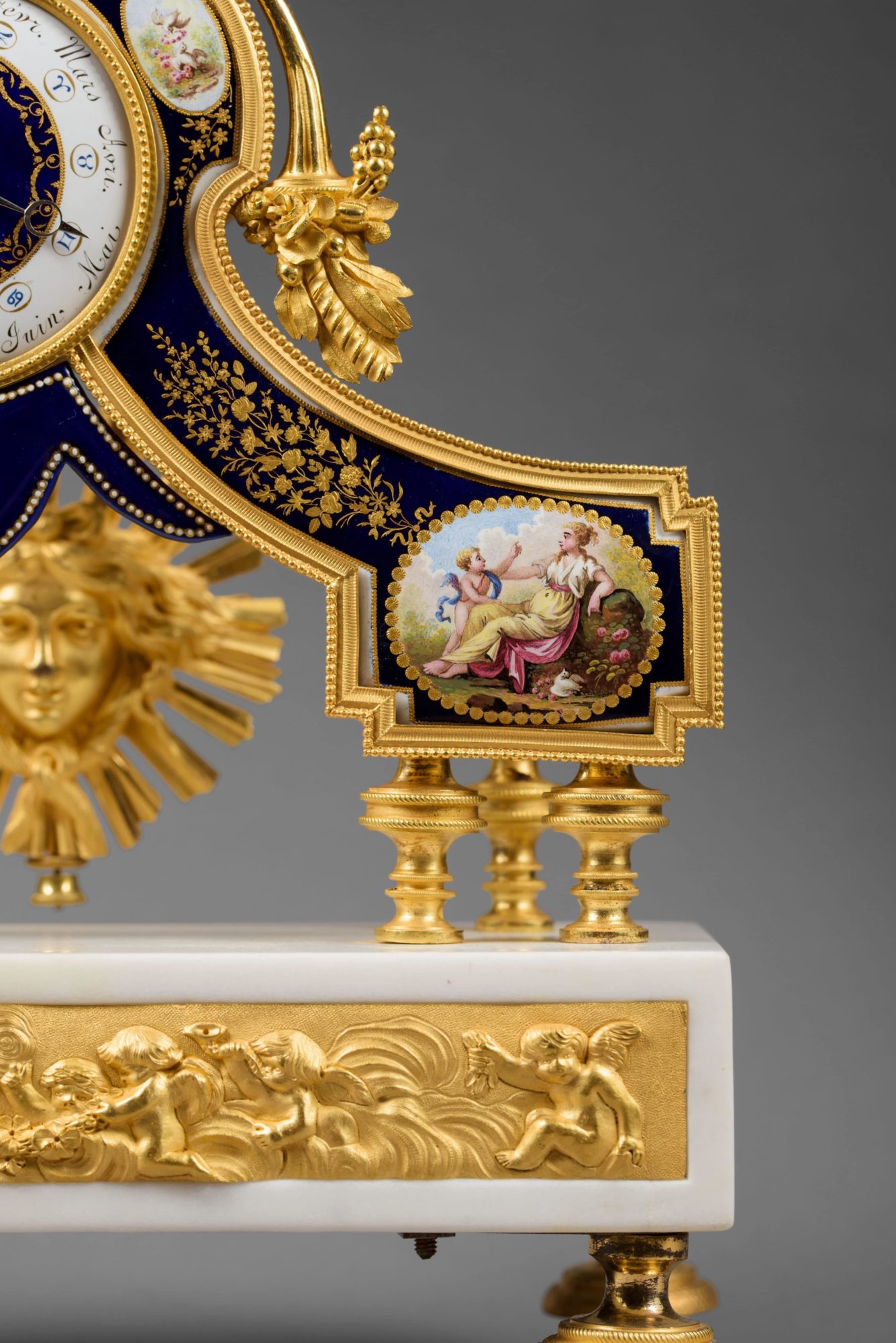Rare Gilt Bronze, Enamel, and White Carrara Marble Skeleton Clock

Enameled dial signed “Ridel à Paris” by clockmaker Laurent Ridel
Enamels Attributed to Joseph Coteau (1740-1801)
Paris, end of the Louis XVI period, circa 1790
The main white enamel chapter ring, revealing the intricately cut wheels of the mechanism, is graduated with the Arabic numeral hours, fifteen-minute intervals, and date, which are indicated by means of four hands, two made of pierced gilt brass and two of blued steel. A blued steel Breguet hand points to the days of the week and their corresponding Zodiac signs, along the outer edge. A third dial in the clock’s upper portion indicates the phases and age of the moon on an enameled disk, featuring a grisaille-painted moon against a starry blue sky. The main ring dial reveals the eight-day movement through its centre, with outer count wheel, two barrels, a pin pallet escapement, and knife-edge suspension. The hours and half hours are struck on a bell. The pendulum features a magnificent Apollo mask with radiating sunrays.
The frame is painted on enamel with a dark blue ground, with swags of flowers and foliage, and features four oval medallions, two depicting doves and rose wreaths, and the other two decorated with scenes related to the theme of Cupid and Venus. A central cartouche bears the clockmaker’s name: Ridel à Paris”. The clock is elaborately adorned with finely chased gilt bronze mounts. Surmounting it, an eagle with spread wings, holding a thunderbolt in its claws, represents the god Jupiter. The frame is further decorated with cornucopias, fluting, beading, flower and leaf wreaths, and stylized rosettes and palmettes. The quadrangular white marble base is adorned with friezes; the one on the façade, after the sculptor Clodion, depicts putti among clouds. The clock is raised on four knurled gilt bronze toupie feet.
Discover our entire collection of antique skeleton clocks for sale online or at the gallery.
La Pendulerie is the specialist in fine and rare antique clocks, based in Paris.
Among the small number of known comparable clocks, one skeleton clock with enamels by Joseph Coteau is today in the Musée des Arts Décoratifs in Paris (illustrated in Tardy, Les Plus Belles Pendules Françaises, 1994, p. 206, pl. XLII). A second clock, also signed “Ridel à Paris”, with enamels by Joseph Coteau that are dated 1796 and a similar Clodion-inspired frieze, is in the Musée François Duesberg in Mons (see Pierre Kjellberg, Encyclopédie de la Pendule Française du Moyen Age au XXe Siècle, 1997, p. 319, pl. B). A third clock is illustrated in Johann Willsberger, Clocks and Watches, 600 Years of the World’s Most Beautiful Timepieces, 1975. One further similar clock, whose dial is signed Laguesse à Liège and whose enamels, dated 1796, are by Joseph Coteau, is displayed in the Pavlovsk Palace in Saint Petersburg (E. Ducamp, Pavlovsk, Les Collections, 1993, p. 186, pl. 17).
Laurent Ridel, one of the most important Parisian clockmakers of the late 18th century and the early years of the 19th century, signed his works “Ridel à Paris”. Although the date at which he became a master is not known, we know he opened a workshop in the rue aux Ours and quickly became successful among Parisian collectors of luxury horology. Like all the finest clockmakers of the period, Ridel obtained his cases from the best artisans of the day, including the bronziers Feuchère, Denière and Deverberie, the enamelers Coteau and Merlet, and the spring maker Monginot l’aîné. He soon gained a wealthy and discerning clientele, among them Jean-Marie Chamboissier, the jeweler Louis-Nicolas Duchesne, and Mesdames de France – the daughters of Louis XV – for whom Ridel made a clock in 1789 that was intended for their palace in Bellevue.
Joseph Coteau (1740 - 1801)
The most renowned enameller of his time, he worked with most of the best contemporary Parisian clockmakers. He was born in Geneva, where he was named master painter-enameler of the Académie de Saint Luc in 1766. Several years later he settled in Paris, and from 1772 to the end of his life, he was recorded in the rue Poupée. Coteau is known for a technique of relief enamel painting, which he perfected along with Parpette and which was used for certain Sèvres porcelain pieces, as well as for the dials of very fine clocks. Among the pieces that feature this distinctive décor are a covered bowl and tray in the Sèvres Musée national de la Céramique (Inv. SCC2011-4-2); a pair of “cannelés à guirlandes” vases in the Louvre Museum in Paris (see the exhibition catalogue Un défi au goût, 50 ans de création à la manufacture royale de Sèvres (1740-1793), Musée du Louvre, Paris, 1997, p. 108, catalogue n° 61); and a ewer and the “Comtesse du Nord” tray and bowl in the Pavlovsk Palace in Saint Petersburg (see M. Brunet and T. Préaud, Sèvres, Des origines à nos jours, Office du Livre, Fribourg, 1978, p. 207, fig. 250). A blue Sèvres porcelain lyre clock by Courieult, whose dial is signed “Coteau” and is dated “1785”, is in the Musée national du château in Versailles; it appears to be identical to the example mentioned in the 1787 inventory of Louis XVI’s apartments in Versailles (see Y. Gay and A. Lemaire, “Les pendules lyre”, in Bulletin de l’Association nationale des collectionneurs et amateurs d’Horlogerie ancienne, autumn 1993, n° 68, p. 32C).













